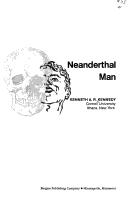| Listing 1 - 10 of 154 | << page >> |
Sort by
|
Book
Year: 1958 Publisher: Utrecht : Kemink,
Abstract | Keywords | Export | Availability | Bookmark
 Loading...
Loading...Choose an application
- Reference Manager
- EndNote
- RefWorks (Direct export to RefWorks)
Book
ISBN: 9780660252568 Year: 2019 Publisher: Gatineau, Quebec Canadian Museum of History = Musée canadien de l'histoire
Abstract | Keywords | Export | Availability | Bookmark
 Loading...
Loading...Choose an application
- Reference Manager
- EndNote
- RefWorks (Direct export to RefWorks)
"In this encounter with the Neanderthals, you will rediscover a species that is closer to us than previously thought. Long considered primitive, the Neanderthals are now considered to be full-fledged humans. Drawing upon the most recent scientific discoveries, this souvenir catalogue takes a new look at this species of the genus Homo. It features exceptional fossils rarely shown to the public from Europe's most prominent research institutions, including the Musée de l'Homme in Paris. The Neanderthals were great hunters, worked stone, mastered the use of fire and buried their dead. They lived throughout Eurasia for 350,000 years before mysteriously disappearing 30,000 years ago."--

ISBN: 0808711164 Year: 1975 Publisher: Minneapolis (Minn.): Burgess
Abstract | Keywords | Export | Availability | Bookmark
 Loading...
Loading...Choose an application
- Reference Manager
- EndNote
- RefWorks (Direct export to RefWorks)
Digital
Year: 2020 Publisher: Chaudfontaine Éditions du Prof Francis Baldewyns
Abstract | Keywords | Export | Availability | Bookmark
 Loading...
Loading...Choose an application
- Reference Manager
- EndNote
- RefWorks (Direct export to RefWorks)
Book
Year: 1999 Publisher: Stuttgart Reinsburg Verlag
Abstract | Keywords | Export | Availability | Bookmark
 Loading...
Loading...Choose an application
- Reference Manager
- EndNote
- RefWorks (Direct export to RefWorks)
Book
ISBN: 0192518127 0192518119 Year: 2019 Publisher: Oxford, England : Oxford University Press,
Abstract | Keywords | Export | Availability | Bookmark
 Loading...
Loading...Choose an application
- Reference Manager
- EndNote
- RefWorks (Direct export to RefWorks)
Since the late 1980s the dominant theory of human origins has been that a 'cognitive revolution' (C.50,000 years ago) led to the advent of our species, Homo sapiens. As a result of this revolution our species spread and eventually replaced all existing archaic Homo species, ultimately leading to the superiority of modern humans.Or so we thought.As Clive Finlayson explains, the latest advances in genetics prove that there was significant interbreeding between Modern Humans and the Neanderthals. All non-Africans today carry some Neanderthal genes. We have also discovered aspects of Neanderthal behaviour that indicate that they were not cognitively inferior to modern humans, as we once thought, and in fact had their own rituals and art. Finlayson, who is at the forefront of this research, recounts the discoveries of his team, providing evidence that Neanderthals caught birds of prey, and used their feathers for symbolic purposes. There is also evidence that Neanderthals practised other forms of art, as the recently discovered engravings in Gorham's Cave Gibraltar indicate.Linking all the recent evidence, The Smart Neanderthal casts a new light on the Neanderthals and the "Cognitive Revolution". Finlayson argues that there was no revolution and, instead, modern behaviour arose gradually and independently among different populations of Modern Humans and Neanderthals. Some practices were even adopted by Modern Humans from the Neanderthals. Finlayson overturns classic narratives of human origins, and raises important questions about who we really are.
Book
ISBN: 9782738157232 2738157238 Year: 2022 Publisher: Paris : Odile Jacob,
Abstract | Keywords | Export | Availability | Bookmark
 Loading...
Loading...Choose an application
- Reference Manager
- EndNote
- RefWorks (Direct export to RefWorks)
Et si nous nous étions fourvoyés sur ce que fut l'homme de Néandertal ? Dans un véritable récit de voyage, Ludovic Slimak retrace son parcours de chercheur et nous entraîne dans une étonnante enquête archéologique. Pendant trente ans, il a inlassablement traqué ce qu'il appelle la créature. Créature, comme l'un de ces êtres qu'on apercevrait de loin, dans les brumes, sans vraiment savoir ce qu'il est, sans vraiment savoir le qualifier. Son périple nous emmène en mille détours depuis les étendues glacées du cercle polaire jusque sur les traces d'étonnants cannibales vivant dans de profondes forêts tempérées méditerranéennes. Se confrontant aux vestiges de l'homme de Néandertal, il décrit une créature inattendue et dont la nature pourrait bien nous avoir totalement échappé. Constat d'échec ? Serions-nous incapables de concevoir une intelligence trop divergente de la nôtre ? La créature humaine est décryptée d'une plume vive, parfois sarcastique, qui affronte sans détour nos fantasmes et nos projections sur cette humanité éteinte. Cette créature humaine, c'est Néandertal, bien sûr. Mais c'est nous, aussi, dont un portrait inattendu émerge de ce regard croisé à travers les millénaires.
Néandertaliens --- Néandertaliens. --- Neanderthals. --- Neanderthals
Book
Year: 1996 Publisher: Andenne: Archéologie andennaise,
Abstract | Keywords | Export | Availability | Bookmark
 Loading...
Loading...Choose an application
- Reference Manager
- EndNote
- RefWorks (Direct export to RefWorks)
Neanderthals --- Europe
Book
Year: 1929 Publisher: Chicago Field Museum of Natural History
Abstract | Keywords | Export | Availability | Bookmark
 Loading...
Loading...Choose an application
- Reference Manager
- EndNote
- RefWorks (Direct export to RefWorks)
Book
Abstract | Keywords | Export | Availability | Bookmark
 Loading...
Loading...Choose an application
- Reference Manager
- EndNote
- RefWorks (Direct export to RefWorks)
Paleolithic period --- Neanderthals --- Neanderthals. --- Paleolithic period. --- Germany.
| Listing 1 - 10 of 154 | << page >> |
Sort by
|

 Search
Search Feedback
Feedback About UniCat
About UniCat  Help
Help News
News